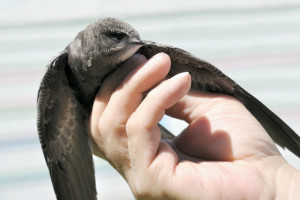The warm temperatures of spring have finally arrived, bringing with them a number of species of migratory birds. Unfortunately, many of these birds may view your chimney as a safe place to build a nest and lay their eggs. Chimney swifts are one species in particular that are known for nesting in chimneys.
What are chimney swifts?
Chimney swifts are easy to recognize, even for those who don’t consider themselves birdwatchers! Swifts are grey and brown and have small, cigar shaped bodies with wide, short bills. They are most easily recognized by their distinctive calls and unique flying patterns; chimney swifts make sharp, jerky movements and seem to dart around when flying.
Like many migratory birds, chimney swifts spend the winter in South America before flying north throughout North American for the nesting season in spring. While chimney swifts originally nested in dead or hollow trees, the destruction of many of their natural habitats forced the small birds to adapt. As their name implies, they are now known for nesting primarily in chimneys.
How chimney swifts get into your chimney
The most common way for chimney swifts to get into a chimney is through a missing or damaged chimney cap. Because swifts are so small, even gaps as small as one to two inches provide enough space for the birds to squeeze through. One in the chimney, swifts build their nests vertically along the walls of the chimney, causing damage to the flue and flue liner.
Oftentimes the best way to prevent swifts from getting into your chimney is regular preventative maintenance. Services like chimney sweepings and inspections can make sure chimneys are in good condition with no damage to the chimney cap or other chimney components through which swifts can gain entry.
I think I have swifts in my chimney – now what?
While the presence of any animal in the chimney can be troubling, having swifts in your chimney is especially problematic. Chimney swifts are one of several bird species protected under the Federal Migratory Birth Treaty Act. This law protects migratory birds like the chimney swift, making it a federally punishable offense to remove or destroy nests that have eggs or hatchlings. Because of this, homeowners must wait for the chimney swift hatchlings to leave the nest before repairs can be made.
Luckily for homeowners, chimney swifts have a short nesting cycle. Chimney swift hatchlings leave the nest approximately six weeks after the eggs are laid; once the hatchlings leave the nest, repairs can be made. A certified chimney sweep can help remove the remnants of the nest as well as repair any damage the nest caused to the chimney. Most importantly, they can find and repair how the swifts got in.
Chimney swifts are more than just a minor nuisance; they can cause serious damage to your chimney and flue while exposing you and your family to bacteria and disease. Because of this, regular chimney maintenance is important to keeping swifts out of your chimney. For more information on chimney swifts or to schedule your next chimney inspection contact Mason’s Chimney Service today.

